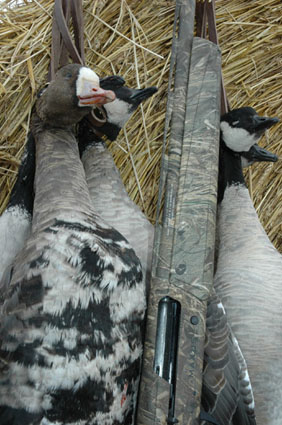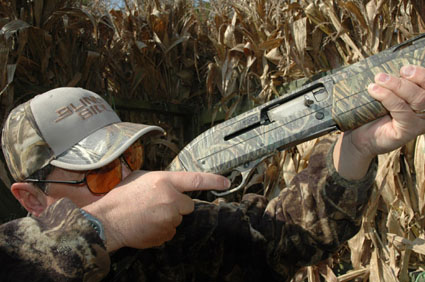 Want to start an argument? That’s easy. Walk into the shotgun section of any major sporting goods dealer and say in a loud, clear voice — “The (fill in name of favorite shotgun) is the best duck gun on the market, and I’ll tell you why!” Chances are that within seconds, you’ll have a line, and a long line at that, forming to your front consisting of avid waterfowlers just dying to explain in detail why you’re wrong.
Want to start an argument? That’s easy. Walk into the shotgun section of any major sporting goods dealer and say in a loud, clear voice — “The (fill in name of favorite shotgun) is the best duck gun on the market, and I’ll tell you why!” Chances are that within seconds, you’ll have a line, and a long line at that, forming to your front consisting of avid waterfowlers just dying to explain in detail why you’re wrong.
The search for the ‘perfect’ waterfowl gun has been going on nearly as long as has the debate as to whether or not the 6mm centerfire rifle cartridge is an acceptable caliber for the general white-tailed deer hunting public. And, to tell the truth, with about as many cut-and-dried Final Answer decisions. What’s the reason behind this apparent lack of reason? It all lies in that one word — perfect.
For example, the mere existence of an autoloading shotgun that can, without hesitation or stutter-step, cycle 2 3/4-inch, 3-inch, and 3 1/2-inch ammunition should not lead one to the assumption or conclusion that this, therefore, is the perfect waterfowl gun. True, such a piece might prove a versatile firearm. And perhaps even a mechanically superior piece at that. But perfect?
This said, choosing a shotgun for waterfowling becomes not a search for perfection, but rather a quest combining personal preference, ability and a short list of what we’ll call common denominators, all of which when taken together can create something — well, something close to perfect. In no particular order, these common denominators include:
Simple — It doesn’t matter if we’re talking about shotguns or space shuttles; the fact remains that simple is always better. This probably explains why so many waterfowlers opt for pump-action shotguns rather than the fancy, new-fangled autoloaders. And there’s probably quite a bit of truth in these decisions; however, thanks to advancements in design, today’s modern autoloaders are in many cases as elemental from a parts-and-operation standpoint as are the pump-guns of old. Simple in design and function, too, translates into easy to clean and maintain, which in turn takes us to Rule B: dependability.
Dependable — Nothing is quicker to frustrate than something that should work and doesn’t. Hence, the duck hunter’s shotgun needs to be dependable. Yes, there are times when the gun gremlins will invade the closet and create havoc among small yet very vital parts such as O-rings and operating handles. And, yes, dependability does rely in large part on an observance of routine and thorough maintenance. Still, the rules here are relatively simple. Keep it clean, keep it well-fed, and it will reward you with dependability.
 Durable and rugged — In more cases than not, duck hunting is not for the man or woman who doesn’t like to get dirty. Mud, dirt, dust, sand, snow, water, weeds, dog hair — it’s just all part of the duck hunting scene. Sure, we can try to keep both our gear and ourselves as clean and dirt-free as possible; however, such attempts are often an exercise in futility. That’s why, plain and simple, the waterfowler’s firearm needs to be both durable and rugged. This shotgun can and will operate under a wide range of weather and environmental conditions. And while we will try to prevent them, scratches, dings and dents are inevitable. Still, this particular firearm should stand up well to what many, myself included, could only call abuse. But it’s kind abuse.
Durable and rugged — In more cases than not, duck hunting is not for the man or woman who doesn’t like to get dirty. Mud, dirt, dust, sand, snow, water, weeds, dog hair — it’s just all part of the duck hunting scene. Sure, we can try to keep both our gear and ourselves as clean and dirt-free as possible; however, such attempts are often an exercise in futility. That’s why, plain and simple, the waterfowler’s firearm needs to be both durable and rugged. This shotgun can and will operate under a wide range of weather and environmental conditions. And while we will try to prevent them, scratches, dings and dents are inevitable. Still, this particular firearm should stand up well to what many, myself included, could only call abuse. But it’s kind abuse.
Comfortable — By comfort, I mean simply that a shotgun’s of little or no use if you don’t shoot it well. Esthetics are nice, certainly, but I’ve been witness to some tremendous displays of shooting by hunters wielding some of the ugliest shotguns on the face of the planet. Tape, paint, scratches, dents. It didn’t seem to matter, least of all to the ducks. The bottom line is, then, that it doesn’t matter what the piece looks like. Successful shotgunning, whether the target be canvasbacks, Canadas, cockbirds, or clays, depends on one thing and one thing only — the individual at the rear of the butt plate.
Versatile — I debated whether or not today’s waterfowl gun must be versatile, where versatility here translates into a definition that perhaps reads “one gun capable of performing several different and diverse functions.” A large part of my hesitancy in this regard stems from a quote from my father, who today shoots the same 2 3/4-inch only, straight 28-inch modified barrel Remington Model 1100 that he began his waterfowling career with in the early 1970s. “There’s not a game bird on this planet that I can’t kill with this gun,” he said every time I suggested he invest in a new 3-inch version of his old favorite. And over the past three decades, he’s proved himself right time after time. Still, and my father’s words notwithstanding, I will say this — versatility, be it interchangeable choke tubes or chambers capable of handling shotshells from 2 3/4 to 3 1/2 inches, will in most hunting circles be viewed as a definite plus. A requirement? No. A pleasure? Definitely.
So what’s YOUR perfect waterfowling gun? Leave your answer in the comments and be prepared to defend your choice!






